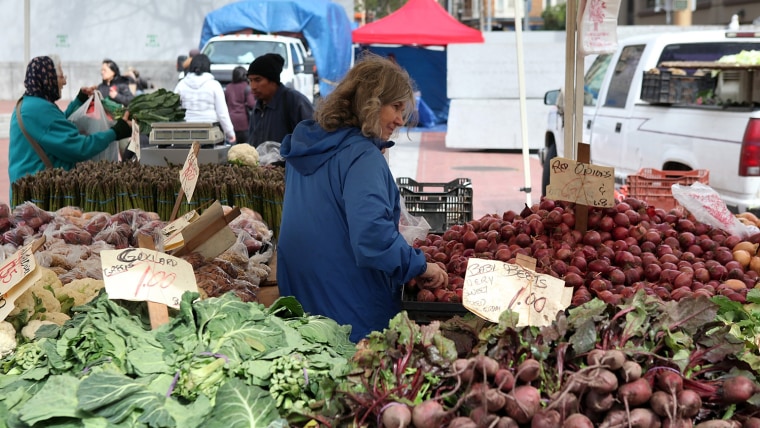The grocery store is dead. Long live the grocery store!
A shining example of post-war success and convenience, supermarkets once were practically the only place most Americans went to shop for groceries.
Today, we’re all still buying groceries. We’re just not buying them at the supermarket anymore. Last year, Americans bought only 51 percent of our groceries at traditional supermarkets, down from 66 percent just 11 years earlier, according to the Wall Street Journal. So, where are shoppers filling their carts if not at the local Safeway or Kroger?
Low prices and convenience have made big-box discounters Wal-Mart and Target major players in the grocery game. In fact Wal-Mart, the nation’s largest retailer, is also the nation’s largest grocer. The hunger for bargains also is driving Americans to club stores, like Costco and Sam’s Club.
The quest for fresh and organic also has led some shoppers to small, locally owned specialty stores and farmers markets, which are booming. “People are looking to shop local. After years of struggling, local markets are having a resurgence,” said Mike Tesler, founding partner at Retail Concepts, a consulting firm, and adjunct professor at Bentley University in Waltham, Mass.
Traditional supermarkets also face growing competition from the Internet, with online delivery services like AmazonFresh and Pea Pod.
But how we go about getting that food can vary widely depending on our age. Baby boomers may be the last generation of consumers to faithfully shop the local grocery store, as brokerage firm Jefferies pointed out in a report. Retailers are now looking to Millennials, a loosely defined group born roughly from the late 1970s to the 1980s and beyond, to fill the shopping gap.
Even in an age when we’re busier and more crunched for time than ever before, younger shoppers are giving up the convenience of the one-stop shop grocery store and are, instead, shopping around. By mixing and matching, Millennials seem to be trying to satisfy a variety of needs. They’re saving money at Costco and Sam’s Club, getting quality and freshness at the farmers market and getting convenience at Target, Wal-Mart or the Internet.
Perhaps these complicated shopping habits are a reflection of the complicated times in which we live. Tesler noted that many of today’s college graduates are leaving school with tremendous debt. They’re having trouble finding good jobs and often find themselves underemployed. At the same time, we understand better than ever the importance of eating healthily. By contrast, when the Boomers came of age, jobs were relatively stable and people could expect to get a decent job where perhaps they could stay 'til retirement.
In the 1960s, Americans were worried about the Cold War, not the obesity epidemic. It seemed futuristic and progressive to grab space-age frozen dinners at the supermarket, and no one was fretting that they were filling their kids up with all kinds of preservatives and who-knows-what-else.
While Americans have changed a lot in the last 30 years, grocery stores haven’t. “People used to organize menus and plan meals. Most of us now have no idea what we’re feeding our kids tonight,” said Paco Underhill, author of “What Women Want: The Global Marketplace Turns Female-Friendly.”
These days, when we’re not looking for convenience and economy, we’re looking for fresh and healthy. We’re also looking to satisfy a need to connect on a more personal level. This may help explain the gaining popularity of the local farmers market.
“Farmers markets are a crossing of shopping and recreation,” said Paco Underhill, author of “What Women Want: The Global Marketplace Turns Female-Friendly.” “No one would ever describe going to the grocery store as fun.”
Grocery stores just aren’t doing it for us like they used to. But, could we really do without them? For the next 30 days, I’m going to try.
I’m going to participate in the “30 Day No Grocery Store Challenge” and see what it’s like to go without the conveniences of my neighborhood supermarket for a full month. The goal of the challenge is to eat healthier and support small, locally owned businesses at the same time.
The challenge allots you $30 to spend at a grocery store on items that you need but can’t find elsewhere. I’m going to attempt to avoid the grocery store altogether, and use that $30 instead in chain stores like Target and Trader Joe’s.
Theoretically, if you can do something for a month, you’ve formed a habit. Then you’ll forget all about your old chicken nugget, mac-and-cheese ways.
They don’t call it a challenge for nothing. I don’t think the next 30 days will be easy for me. Between the Boomers and Millennials in age, I’m also between them in shopping habits.
I buy about half my groceries from Costco and half from my favorite chain grocery store. I rarely if ever shop at farmers markets or the local butcher.
I’m one of the many Americans who wants to eat healthier, believes in organic food (in theory, if not in actual purchases) and loves the idea of supporting small, local businesses. But, I almost always find practicalities outweighing these ideals.
As the mother of two, preschool-age children, I worry about the extra time commitment of this challenge.
I also worry that this commitment won’t be sustainable for my budget. Will budget considerations make me consider other changes to my diet as well?
Over the next several weeks, I’ll report back on my progress and let you know about some of the alternatives to the grocery store that I find.
Dana Macario is a Seattle-area writer who is terrified, yet determined to eat healthy and local for full month.
More money and business news:
